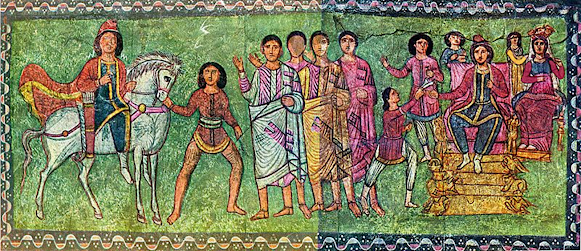Shushan Purim Isru Chag Post
I was going to post this yesterday, but I'm swamped with work...let's just call this the Shushan Purim Isru Chag post...😁
For those who don't know, Dura Europos, a city in eastern Syria, was excavated in the 1930's. One of the most incredible discoveries made there was a well-preserved shul. The shul's walls were decorated with beautiful paintings of scenes from Tanach, such as Eliyahu at Mt. Carmel, the Plishtim being punished for taking the Ark, King David, the First Temple and so forth. One of the most fascinating things about these paintings - which are dated to the years 244-245 CE - is that some of them are based on midrashim. For example, the Eliyahu at Mt. Carmel painting clearly shows Chiel Beit Ha'eli hiding in the Baalic altar and being killed by a snake (alluded to in Shemot Rabbah 15:16 and Pesikta Rabbati 4; stated explicitly in Yalkut Shimoni on Nach 214).
With regards to Purim, there's an honest-to-goodness Purim panel at that shul:
"In the month of Mihr, on the year 14 and day of Frawardīn
when Hormizd the scribe and the Kardag of the district and the pious scribe
and they came to this district of the Jews, to this place of worship of the god of gods
of the Jews, they saw this painting, they saw and liked ... saw
... painting ..."
It's possible that they liked the painting because it was done in Sassanian style and to them, this was a sign that they were the rightful heirs of the powerful Achaemenid Empire (the lineage of Koresh, Daryavesh, Achashverosh, etc). For more info, see here.

Comments
Post a Comment